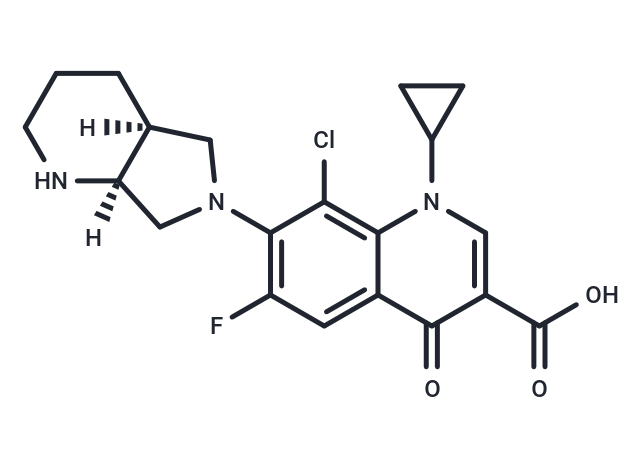Shopping Cart
- Remove All
 Your shopping cart is currently empty
Your shopping cart is currently empty

BAY-Y 3118, a new chlorofluoroquinolone, has antimicrobial activity.

| Pack Size | Price | Availability | Quantity |
|---|---|---|---|
| 25 mg | $658 | 8-10 weeks | |
| 50 mg | $855 | 8-10 weeks | |
| 100 mg | $1,410 | 8-10 weeks |
| Description | BAY-Y 3118, a new chlorofluoroquinolone, has antimicrobial activity. |
| In vitro | BAY-Y 3118 exhibits potent activity against Haemophilus influenzae, Moraxella catarrhalis, Acinetobacter baumannii, Xanthomonas maltophilia, gram-positive cocci, and anaerobes, with MIC50s and MIC90s of ≤0.015 and ≤0.015, ≤0.015 and ≤0.015, 0.03 and 2, 0.25 and 0.5, 0.06 and 1, and 0.12 and 0.25 μg/mL, respectively [1]. It achieves a cellular concentration-to-extracellular concentration ratio above 6.3 at extracellular concentrations of 2 to 100 mg/L, demonstrating rapid, reversible, nonsaturable uptake. Its intracellular penetration is significantly influenced by environmental temperature and cell viability. BAY-Y 3118 attains high intracellular levels within human polymorphonuclear leukocytes (PMNs) and remains active within these cells [2]. In vitro, BAY-Y 3118 is rapidly bactericidal, exhibiting a postantibiotic effect for 3 hours after antibiotic removal, and effectively eliminates L. monocytogenes from infected L929 cells [3]. |
| In vivo | Immunocompetent mice treated with 4 mg every 12 hours are rapidly cured, with interleukin 6 and gamma interferon levels in mouse sera declining swiftly. Additionally, treatment in immunocompetent mice with 2 mg of BAY-Y 3118 every 12 hours results in a greater initial reduction in listerial counts in organs compared to 2 mg of ampicillin every 12 hours [3]. |
| Molecular Weight | 405.85 |
| Formula | C20H21ClFN3O3 |
| Cas No. | 151213-16-0 |
| Relative Density. | 1.486 g/cm3 (Predicted) |
| Storage | Powder: -20°C for 3 years | In solvent: -80°C for 1 year | Shipping with blue ice. |

Copyright © 2015-2024 TargetMol Chemicals Inc. All Rights Reserved.